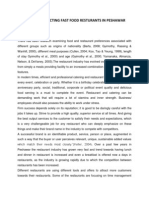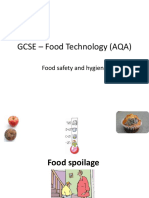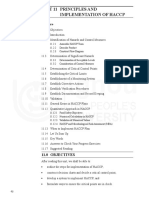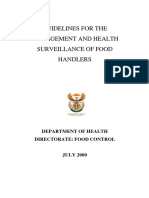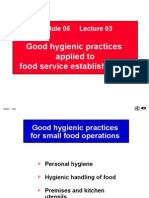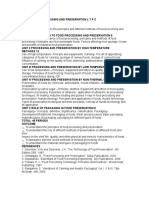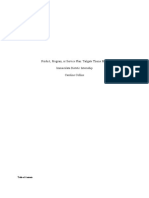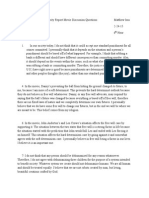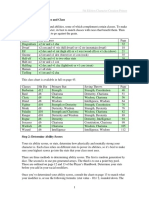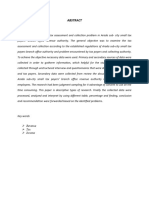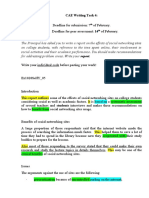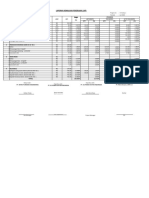Professional Documents
Culture Documents
Lesson 4 Worksheet
Lesson 4 Worksheet
Uploaded by
Amy EvansOriginal Title
Copyright
Available Formats
Share this document
Did you find this document useful?
Is this content inappropriate?
Report this DocumentCopyright:
Available Formats
Lesson 4 Worksheet
Lesson 4 Worksheet
Uploaded by
Amy EvansCopyright:
Available Formats
Lesson 4 Worksheet Nutrition and Foodservice Professional Training Program
Instructions: Complete and submit this worksheet by uploading it into Blackboard for your UND instructor to
review and grade. The worksheet material covers content found in Chapters 17-20 in your textbook:
Foodservice Management by Design, 3rd edition by Kristi Salisbury & Dee Legvold.
There are four (4) Sections in this worksheet:
(1) In Your Own Words: Questions that you answer in your own words (short answer)
(2) CDM Math: Professional problems or calculations using numbers or formulas
(3) Ethics Check: A scenario or question related to professional ethics
(4) Project: Hands-on projects to deepen your understanding of the material
In Your Own Words
Chapter 17: Safe Food Handling: Personnel
1. How would you handle the situation of an employee who has a visibly infected hangnail on her hand?
I would have the employee bandage the finger with a waterproof band aid and wear clean disposable gloves,
which she changes often.
2. What is a key objective of ergonomics in foodservice? It is to design the work environment to help
prevent injuries. Example: repetitive motion.
3. What are three (3) possible solutions to the ergonomic hazard of reaching/lifting? The figure in Chapter
17 labeled “Ergonomic Hazards and Solutions” may be helpful when you answer this question.
1. Offer height adjustable counters
2. Train on proper lifting techniques
3. Use the buddy system when lifting heavy loads.
4. How can the CDM best ensure hand washing? Ensure proper training, provide hand washing sink
with soap and paper towel, observe that these practices are being implemented, post reminders.
University of North Dakota Nutrition & Foodservice Professional Training Program©2020
Lesson 4 Worksheet Nutrition and Foodservice Professional Training Program
Chapter 18: Safe Food Handling: Purchasing, Receiving and Storage
1. What are three (3) considerations when choosing a vendor for your foodservice operation?
1. Does the vendor have HACCP practices in place.
2. Does the vendor have proof of government inspection of meat.
3. Can the vendor make deliveries when needed.
2. List four (4) ways a foodservice operation can lose money in the process of receiving and storage.
1. When damaged or spoiled product is accepted.
2. Frozen food is not kept frozen. Signs of frozen food thawed and refrozen
3. Raw meat cannot be stored above ready to eat food because they could contaminate these items.
4. Not following proper rotation; first in first out.
3. How would you handle an unmarked product in your storeroom? Discard this.
4. What is FIFO and how do you use it in your receiving and storage process?
First in First out. All new product must be stored behind the current product in order to use the current
products first.
Chapter 19: Safe Food Handling: Food Preparation
1. Why is following guidelines to decrease food borne illness so important for Certified Dietary
Managers?
Especially working with the elderly who have a compromised immune systems, following the
guidelines is vital in keeping everyone safe from food borne illnesses. Food borne illnesses can
potentially kill our residents.
2. List three (3) ways a CDM can ensure food safety in dining services operations.
1. Proper haccp logs are kept.
2. Proper employee hygiene.
3. Proper cooking techniques.
3. Describe when and how disposable gloves should be used and worn in a food service operation.
University of North Dakota Nutrition & Foodservice Professional Training Program©2020
Lesson 4 Worksheet Nutrition and Foodservice Professional Training Program
Disposable gloves should be used when preparing food. Gloves should be changed between tasks
involving different foods, when you touch your skin, when preparing a finished product and while
serving food.
4. What is the first task when establishing a HACCP system? Analyze hazards
5. Explain what is meant by date marking.
Label and date all TCS foods with the item, the date is was prepared and the date that it needs to be
consumed.
6. What should be on the label of leftover chili stored in the cooler after today’s noon meal? Assume
today’s date is October 1, 20xx.
Chili/10-01-20XX
Use By: 10-7-20XX
7. What is a foodborne illness outbreak? How many people must be ill?
8. Name two examples of foodborne pathogens in each category:
Category Pathogen 1 Pathogen 2
Bacteria
Viruses
Parasites
9. List six conditions that encourage bacteria to grow.
1.
2.
3.
4.
University of North Dakota Nutrition & Foodservice Professional Training Program©2020
Lesson 4 Worksheet Nutrition and Foodservice Professional Training Program
5.
6.
10. What does Time/Temperature Control for Safety (TCS) mean? Explain, and give three (3) food
examples.
Definition:
Three (3) Examples:
1.
2.
3.
11. List four (4) ways to thaw food safely.
1.
2.
3.
4.
12. List three (3) ways a CDM can train staff to prevent cross-contamination.
1.
2.
3.
13. At 9AM cooks have placed a half pan of canned vegetables in the steam table to heat for the
noon meal. Explain what is wrong and what is the correct procedure.
14. List two (2) ways to cool food safely.
University of North Dakota Nutrition & Foodservice Professional Training Program©2020
Lesson 4 Worksheet Nutrition and Foodservice Professional Training Program
1.
2.
15. What is the total maximum time a PHF/TCS food should be cooled from 135 ℉ to 41 ℉?
Chapter 20: Safe Food Handling: The Physical Plant
1. List three (3) characteristics to look for when purchasing equipment for your facility.
1.
2.
3.
2. What is the best source for preventative maintenance information on equipment?
3. Why is preventative maintenance important?
4. During a routine safety inspection, a meat slicer is found to have a frayed cord. List three (3) steps
that should be taken.
1.
2.
3.
5. Name three (3) types of chemical sanitizers that you could use on your stainless-steel countertops:
1.
2.
3.
6. List an example of how cleanability can be a part of a kitchen design for:
University of North Dakota Nutrition & Foodservice Professional Training Program©2020
Lesson 4 Worksheet Nutrition and Foodservice Professional Training Program
Selection Cleanability Example
Floors
Walls
Floor drains
Meat slicer
7. What is the difference between clean and sanitary?
8. List at least three (3) components of a cleaning schedule. (Hint: each begins with a “W”)
1.
2.
3.
9. Fill in the blanks: What environmental controls can you check that are important for water supplies?
a. Check for ______________________between an outlet of potable water and unsafe
water.
b. To prevent _________________, provide for an ____________ between an outlet of potable
water and the flood rim (for example: in a sink).
Professional Practice Standards
1. Using the CBDM Practice Standard for Food Safety, list two (2) criteria for Handling and Storing Fresh
Meat & Dairy. https://www.cbdmonline.org/docs/default-source/legacy-docs/practice-standards/
sanitation-safety/food-safety.pdf
1.
2.
2. Using the CBDM Practice Standard for Food Safety, list two (2) ways to implement and evaluate
Criteria 3.2: Food use-by and expiration dates are monitored. (under Standard 3: Handling and Storing
Fresh Produce)
University of North Dakota Nutrition & Foodservice Professional Training Program©2020
Lesson 4 Worksheet Nutrition and Foodservice Professional Training Program
https://www.cbdmonline.org/docs/default-source/legacy-docs/practice-standards/sanitation-safety/
food-storage-guidelines.pdf
1.
2.
University of North Dakota Nutrition & Foodservice Professional Training Program©2020
Lesson 4 Worksheet Nutrition and Foodservice Professional Training Program
CDM Math
Project: Calibrating a Thermometer
Accurate monitoring of temperatures is critical for every CDM, CFPP. In this project, you will calibrate your bi-
metallic stemmed thermometer. The steps are listed in your textbook (Chapter 20). You may also view this
video to watch a demonstration before you calibrate yours: https://youtu.be/oOpxbkM8HNA
1. Describe the steps you took to calibrate a bi-metallic stemmed thermometer.
2. What was the temperature reading of your ice water before you calibrated your thermometer?
3. How often and when should thermometers be calibrated in your department?
University of North Dakota Nutrition & Foodservice Professional Training Program©2020
Lesson 4 Worksheet Nutrition and Foodservice Professional Training Program
Ethics Check
Jen has been the CDM in a lovely facility for 20 years. She enjoys her staff, clients, and co-workers. However,
Jen’s kitchen has had better days. The building is incredibly old, and the kitchen is small. The receiving and
storage area is downstairs, and employees must walk up 12 stairs to get to the kitchen. There is an elevator
that is close but sometimes the staff do not want to wait for it.
Last week, Lou, the receiving clerk, complained of the long wait for the elevator and he said he wanted to
bring the dolly down the stairs to get a case of chicken. Jen told him that she understands it is hard to wait,
but for his safety, he should not bring the dolly down the stairs. He should be patient and wait for the
elevator. She reminded him of the Policy & Procedure for receiving and their recent safety in-service. He also
has signed a contract saying he will not carry objects up or down the stairs. That contract is on file.
Today as Jen was completing the schedule in the office, she heard a crash! Lou decided to take the stairs,
carrying up a large box of paper supplies. He stumbled, caught himself with his hand and immediately felt a
sharp pain.
Lou has a broken wrist and will be out for six weeks. He said it was his fault for not following policy.
1. Employee safety is a concern for CDM, CFPPs. What part of this situation could Jen have had control
over or managed differently?
2. Is Lou’s broken wrist the result of any of Jen’s actions? Explain your answer.
3. What financial implications could result for Jen and Lou? The facility?
4. Does an employee have the right to contact OSHA about a safety concern? Why or why not?
5. Are there any ethical violations in this story? Explain your answer.
University of North Dakota Nutrition & Foodservice Professional Training Program©2020
Lesson 4 Worksheet Nutrition and Foodservice Professional Training Program
Project: Handwashing In-Service
In-Service Practice: Use the following sample handwashing in-service or develop your own. Plan and
present the in-service to at least 3 employees or colleagues.
Date of your in-service: _________________________________________
Number in attendance: _________________________________________
Title of In-Service: ________________________________________________________
List 3 things you did to prepare for the in-service:
1.
2.
3.
How did you assess your learners’ understanding?
What handouts or visuals did you use?
What will you do differently next time you lead an in-service?
University of North Dakota Nutrition & Foodservice Professional Training Program©2020
Lesson 4 Worksheet Nutrition and Foodservice Professional Training Program
SAMPLE Inservice: Hand Washing
Objectives:
● Participants will be able to identify:
o Reasons why hand washing is important
o When hands need to be washed
o Proper hand washing technique
Method:
● Lecture, discussion, handout, demonstration.
Inservice:
● The quantity and variety of microbes that we carry on our hands every day is astounding. Many
illnesses like diarrhea, colds, and other more threatening diseases can be transferred from the hands
to food. Hand washing, when done correctly and often, can help us stay healthy and avoid spreading
disease.
● When should hand washing be done?
o Immediately before starting any food preparation and after breaks.
o After using the bathroom.
o After sneezing or blowing your nose.
o After taking a break, eating a meal, or smoking.
o After touching face and hair.
o After handling soiled equipment, utensils, rags, mops, or garbage.
o After returning to the kitchen from any other area.
o During food preparation as often as necessary to prevent contamination, especially when working
with raw food or when changing tasks.
o When using plastic gloves, the same rules apply. Remember to wash hands prior to wearing gloves
and change gloves after breaks, touching raw foods, changing tasks, etc.
● How to wash hands correctly:
o First dispense the towel if it does not come from a self-dispensing unit.
o Wet hands and arms with warm water.
o Use soap to lather hands and arms.
o Wash all surfaces thoroughly, including wrists, palms, the backs of hands, fingers and under the
fingernails. A nailbrush may be used to clean under the nails and between fingers.
o Wash for about 20 seconds. To help you remember, sing the “Happy Birthday Song,” or the
“Alphabet Song” twice while washing.
o Rinse thoroughly under warm running water. Avoid touching the inside of the sink.
o Dry hands with a disposable towel. Do not use kitchen towels to dry hands.
o Turn off the faucet using the paper towel.
University of North Dakota Nutrition & Foodservice Professional Training Program©2020
Lesson 4 Worksheet Nutrition and Foodservice Professional Training Program
o Use a paper towel to open the door to the bathroom after you have washed your hands.
Doorknobs and handles are sources of contamination as well.
o Dispose of the paper towel in a step garbage can. Do not lift the lid of the garbage can or you will
re-contaminate your hands.
● Learning Activity:
o Divide the group into teams of two people.
o Have one team member wash their hands while the other team member times them and observes
their technique.
o Discuss hand washing procedure and time of scrubbing.
Post Test: Hand Washing Importance and Technique
1. True/False (circle one): Hands should be washed for at least 20 seconds.
2. True/False (circle one): You do not need to wash your hands after going to the bathroom.
3. True/False (circle one): You should wash your hands after handling raw meat.
4. True/False (circle one): Hand washing does not help to prevent the spread of disease.
5. True/False (circle one): You can smoke a cigarette on break without washing your hands
afterwards.
Post-Test Answers:
Hand Washing Importance and Technique
1. True
2. False
3. True
4. False
5. False
Hand washing Inservice
RDs for Healthcare
University of North Dakota Nutrition & Foodservice Professional Training Program©2020
Lesson 4 Worksheet Nutrition and Foodservice Professional Training Program
Case Study: Establishing a HACCP Plan
Eric has just taken a job as a Certified Dietary Manager in a long-term care facility. He learns that the local
health department has begun asking foodservice operations to show a HACCP plan as part of routine health
inspections. He sits down with Kay, the executive chef, to begin planning. Eric says, “Kay, we need to write a
HACCP plan. Where do you think we should begin?” Kay responds, “We already have HACCP on all our
recipes, so I think that’s all we need.” Eric asks to see a recipe for beef stew and asks Kay to describe how the
HACCP plan works. Kay shows him the recipe, and explains, “OK here. Do you see the endpoint cooking
temperature in this recipe procedure? It says to cook the stew to 155° F. This is it. We have a temperature
on every recipe for hot food.”
1. Do you think Eric and Kay have a HACCP plan? Why or why not?
5. List at least three (3) steps of HACCP Eric and Kay will need to address.
1.
2.
3.
6. Suggest a critical control point (CCP), a critical limit, and a corrective action for beef stew. Assume
the stew is made through a cook-to-serve process.
Use this template to document the HACCP plan for Beef Stew, including all relevant Critical Control Points
(CCP), hazards, and critical limits.
Process Possible Critical Limits Monitoring Monitoring Monitoring Corrective Verification Record
Step/CCP Hazards Frequency Who Action Keeping
How
Biological Take Midpoint Cook Thermometer Temperature
Production log
hazard if temperatures and
for the meal.
not cooked endpoint Signed and
to proper dated by cook
temperatur
e
7. How can Eric and Kay set up the appropriate record-keeping system?
8. What else do Eric and Kay need to do to fully implement HACCP in their foodservice department? List
the next step/s:
University of North Dakota Nutrition & Foodservice Professional Training Program©2020
Lesson 4 Worksheet Nutrition and Foodservice Professional Training Program
9. Review two (2) recipes in your facility. Include the recipes with HACCP plan with this worksheet. If
you do not have recipes with a HACCP plan, create one using the template provided or your own
format.
Sample HACCP Plan for Soup
University of North Dakota Nutrition & Foodservice Professional Training Program©2020
Lesson 4 Worksheet Nutrition and Foodservice Professional Training Program
Student Learning Record
Instructions: Complete the Student Learning Record. The Association of Nutrition & Foodservice
Professionals (ANFP) requires that we have a record of student activity in the course by time spent in
classroom and field experiences.
● 120 total classroom hours are required for completion of the course.
You are required to submit this Student Learning Record.
By submitting this form, you are verifying that you are submitting your own work.
Student Learning Record
Classroom
Activity
Hours
Review: Learning Guides & Lesson
Overview
Read & Learn: Chapters &
Resources
Watch & Listen: PowerPoints
Test Your Knowledge-Quiz
Complete & Submit: Worksheet
TOTAL HOURS FOR THIS LESSON
TOTAL HOURS FOR YOUR COURSE
Classroom time refers to the time that you spend reading, doing vocabulary words and ‘Testing Your Knowledge’ questions
related to the assignment. It doesn’t need to be exact, just an estimate.
Lesson 4 Checklist
✔ This completed worksheet
✔ Your recipes with HACCP Plans (x2)
University of North Dakota Nutrition & Foodservice Professional Training Program©2020
Lesson 4 Worksheet Nutrition and Foodservice Professional Training Program
University of North Dakota Nutrition & Foodservice Professional Training Program©2020
You might also like
- The Comprehensive Equipment ManualDocument255 pagesThe Comprehensive Equipment Manualanon_93095014277% (13)
- RSPH Level 4 Award in Haccp Management For Food ManufacturingDocument19 pagesRSPH Level 4 Award in Haccp Management For Food ManufacturingHema HemaNo ratings yet
- Epistemologies of HealingDocument273 pagesEpistemologies of HealingEmilio Lecaros Bustamante0% (1)
- ASSESSMENT 1 - Assignment - Case StudiesDocument7 pagesASSESSMENT 1 - Assignment - Case StudiesSameera100% (1)
- The Return of The Iron Man-Iron Man Chapter 3Document3 pagesThe Return of The Iron Man-Iron Man Chapter 3wemrahNo ratings yet
- FSMA and Food Safety Systems: Understanding and Implementing the RulesFrom EverandFSMA and Food Safety Systems: Understanding and Implementing the RulesNo ratings yet
- Allergens Slides Brown 031617Document16 pagesAllergens Slides Brown 031617almutazimNo ratings yet
- Food Safety in Fast Food RestaurantsDocument10 pagesFood Safety in Fast Food RestaurantsIan PatrickNo ratings yet
- Factors Affecting Fast Food Resturants in PeshawarDocument14 pagesFactors Affecting Fast Food Resturants in PeshawarAli LaeeqNo ratings yet
- Food Poisoning: - Also Known As Foodborne Illness - Is Any Illness That Results FromDocument24 pagesFood Poisoning: - Also Known As Foodborne Illness - Is Any Illness That Results FromTheodiffer Digal TemblorNo ratings yet
- Essential Requirements For Street-Vended Foods On SchoolsDocument20 pagesEssential Requirements For Street-Vended Foods On SchoolsJulieSanchezErsandoNo ratings yet
- Food AllergiesDocument19 pagesFood Allergiesjacky786100% (1)
- GCSE - Food Technology (AQA) : Food Safety and HygieneDocument17 pagesGCSE - Food Technology (AQA) : Food Safety and HygieneLy LyNo ratings yet
- Implementation of HaccpDocument21 pagesImplementation of HaccpAnonymous OPix6Tyk5I100% (1)
- DOH Food HandlersDocument15 pagesDOH Food HandlersmorneNo ratings yet
- Food SafetyDocument51 pagesFood SafetyHeyy NaNo ratings yet
- Food Fortification Basic On PremixDocument36 pagesFood Fortification Basic On PremixAjay SinghNo ratings yet
- Introduction To Food Safety Management and GMP - DownloadDocument23 pagesIntroduction To Food Safety Management and GMP - DownloadShivakumara Arehalli100% (1)
- Sanitary Food Handling in Foodservice: About This ChapterDocument24 pagesSanitary Food Handling in Foodservice: About This ChapterRaul TejedaNo ratings yet
- HaccpDocument8 pagesHaccpYant RUma ButarNo ratings yet
- Catering ScienceDocument2 pagesCatering ScienceNixon GeorgeNo ratings yet
- Food Handlers ManualDocument26 pagesFood Handlers Manualalaa alaaromaNo ratings yet
- Proprietor Responsibility: Control of Food Safety HazardsDocument3 pagesProprietor Responsibility: Control of Food Safety HazardsKenneth Alsola100% (1)
- Institutional Food ManagementDocument10 pagesInstitutional Food ManagementSurya NivruthaNo ratings yet
- 4 Food Haccp 1 08Document12 pages4 Food Haccp 1 08Shiva KumarNo ratings yet
- Document (Menu-1)Document5 pagesDocument (Menu-1)Bilal Hassan juttNo ratings yet
- Food Poisoning and Its Prevention: Baked GoodsDocument4 pagesFood Poisoning and Its Prevention: Baked GoodsOrlando ALVARADONo ratings yet
- HACCP Plan Fruit Salad PDFDocument22 pagesHACCP Plan Fruit Salad PDFAliNo ratings yet
- Food Safety EvaulvationDocument2 pagesFood Safety EvaulvationchinchuNo ratings yet
- HACCP Questions and AnswersDocument3 pagesHACCP Questions and AnswersTerri PerryNo ratings yet
- Implement Food Hygiene ProceduresDocument59 pagesImplement Food Hygiene ProceduresShirmeenanwer100% (1)
- Food Safety, Sanitation, AND Personal Hygiene: Norma Pañares CereñoDocument13 pagesFood Safety, Sanitation, AND Personal Hygiene: Norma Pañares CereñoNorma Panares100% (1)
- Good Hygienic Practices Applied To Food Service EstablishmentsDocument24 pagesGood Hygienic Practices Applied To Food Service EstablishmentsSAB MICHTITYANo ratings yet
- Food Safety and Halal ConceptDocument80 pagesFood Safety and Halal ConceptHafizh PpNo ratings yet
- Restaurant Emergency ProceduresDocument2 pagesRestaurant Emergency ProceduresHarsh RawatNo ratings yet
- Employee Illness Log: Joe Food Service Diarrhea Was Treated by DoctorDocument8 pagesEmployee Illness Log: Joe Food Service Diarrhea Was Treated by DoctorArchie Burchfield100% (1)
- Food Allergy - SRMDocument94 pagesFood Allergy - SRMSrikanth ReddyNo ratings yet
- Food Safety and HygieneDocument19 pagesFood Safety and HygieneRoni SimanjuntakNo ratings yet
- Principles of Safety Hygiene & Sanitation: (Sangene)Document42 pagesPrinciples of Safety Hygiene & Sanitation: (Sangene)gregNo ratings yet
- BNF Food Poisoning Tcm4-662860Document23 pagesBNF Food Poisoning Tcm4-662860clinical_pathologyNo ratings yet
- Registration FormDocument2 pagesRegistration FormAlex Maverick WhittakerNo ratings yet
- SushiDocument9 pagesSushishankarzoneNo ratings yet
- Safe Food Handling QUIZ FINALDocument4 pagesSafe Food Handling QUIZ FINALmtlpcguys100% (1)
- Week 5 Risk MGTDocument10 pagesWeek 5 Risk MGTjudezaNo ratings yet
- HACCP Food Safety Pp11 30 Rev10 02Document20 pagesHACCP Food Safety Pp11 30 Rev10 02Anisa Mohd Azhar100% (1)
- SUshiDocument33 pagesSUshiBulkholderia GladioliNo ratings yet
- Allergen ControlDocument20 pagesAllergen Controlmedtaher missaoui100% (1)
- Food Safety Word ScrambleDocument1 pageFood Safety Word ScrambleHomeFoodSafetyNo ratings yet
- (World Health Organization) FAO WHO Guidance To Go HACCPDocument84 pages(World Health Organization) FAO WHO Guidance To Go HACCPNoor Wahyu Sugeng RNo ratings yet
- The Food and Beverage DepartmentDocument40 pagesThe Food and Beverage DepartmentChristian CandareNo ratings yet
- Fd7103 Food Processing and PreservationDocument1 pageFd7103 Food Processing and PreservationKevinXavier0% (1)
- Alsop 17 A Laundry and Linen UseDocument2 pagesAlsop 17 A Laundry and Linen UseChandan Srivastava100% (1)
- Food Microbiology: Prepared by Samira Fattah Assis. Lec. College of Health sciences-HMUDocument32 pagesFood Microbiology: Prepared by Samira Fattah Assis. Lec. College of Health sciences-HMUAshish SahuNo ratings yet
- Theme Meal Final-1Document25 pagesTheme Meal Final-1api-346187971No ratings yet
- I. Introduction To Food ProductionDocument50 pagesI. Introduction To Food ProductionMa.Lourdes Corpuz100% (1)
- Haccp Rev.4 (Dec.2016)Document115 pagesHaccp Rev.4 (Dec.2016)Ejay AbergasNo ratings yet
- Nutritional Diagnosis PresentationDocument27 pagesNutritional Diagnosis PresentationEddie ChenNo ratings yet
- Validation of Food Safety Control MeasuresDocument3 pagesValidation of Food Safety Control Measuresbhalesh100% (1)
- HACCP Plan Content ChecklistDocument2 pagesHACCP Plan Content ChecklistIsaac ArthurNo ratings yet
- How Better Outbreak Investigations Can Make The Food Supply SaferDocument64 pagesHow Better Outbreak Investigations Can Make The Food Supply SaferNational Press FoundationNo ratings yet
- Food Borne Illness - Hazards & PreventionDocument46 pagesFood Borne Illness - Hazards & Preventionkcnit trainingNo ratings yet
- Unit 1 - Use Hygienic Practices For Food SafetyDocument30 pagesUnit 1 - Use Hygienic Practices For Food Safetyapi-505030460No ratings yet
- Custom Couple Keychainsvsifj PDFDocument1 pageCustom Couple Keychainsvsifj PDFdreamshow8No ratings yet
- Vehicle Dynamics Example ProblemsDocument12 pagesVehicle Dynamics Example ProblemsMohammed ImranNo ratings yet
- Student Fare Discount Enforcement ActDocument1 pageStudent Fare Discount Enforcement Actapi-3750482No ratings yet
- The Self As Cognitive ConstructDocument3 pagesThe Self As Cognitive ConstructKyla EsteronNo ratings yet
- Chapter 26 NotesDocument106 pagesChapter 26 NotesFrancesca D'AnnunzioNo ratings yet
- Minority Report Movie Discussion QuestionsDocument2 pagesMinority Report Movie Discussion Questionsapi-282212733No ratings yet
- Borderline Personality DisorderDocument9 pagesBorderline Personality DisorderLCNo ratings yet
- 5th Edition Character Creation PrimerDocument5 pages5th Edition Character Creation PrimerDan AmosNo ratings yet
- February 3rd 2011Document27 pagesFebruary 3rd 2011The OntarionNo ratings yet
- Formal & Informal CommunicationDocument17 pagesFormal & Informal CommunicationAnshul BhadouriaNo ratings yet
- MeleseDocument40 pagesMeleseዳግማዊ ጌታነህ ግዛው ባይህNo ratings yet
- Brochure Scinti-Fiesta FinalDocument19 pagesBrochure Scinti-Fiesta FinalMahender SinghNo ratings yet
- CAE Writing Task 4: of February. of February.: TH THDocument4 pagesCAE Writing Task 4: of February. of February.: TH THМилана ИгоревнаNo ratings yet
- BUPRG Note - Black Start DGDocument12 pagesBUPRG Note - Black Start DGvinay.vishwakarmaNo ratings yet
- Nirav ModiDocument6 pagesNirav ModiRhythm KhetanNo ratings yet
- Topic 2 - Mechanics - IB PhysicsDocument23 pagesTopic 2 - Mechanics - IB PhysicsAzzahra Yeasmin Saika100% (1)
- Laporan Kemajuan Pekerjaan (LKP) : Apln Lot 1 Gi Rantauprapat ExtDocument2 pagesLaporan Kemajuan Pekerjaan (LKP) : Apln Lot 1 Gi Rantauprapat ExtZuspranNo ratings yet
- Seroussi, E. Music in Medieval Ibero Jewish SocietyDocument66 pagesSeroussi, E. Music in Medieval Ibero Jewish SocietyJoaquín Porras OrdieresNo ratings yet
- 005-Astm C 143 2005 Slump of Hydraulic-Cement ConcreteDocument4 pages005-Astm C 143 2005 Slump of Hydraulic-Cement ConcreteDiego GaunaNo ratings yet
- PDF Matlab Machine Learning Recipes A Problem Solution Approach 2Nd Edition Michael Paluszek Ebook Full ChapterDocument53 pagesPDF Matlab Machine Learning Recipes A Problem Solution Approach 2Nd Edition Michael Paluszek Ebook Full Chapterdon.hall698100% (6)
- English Class Ninth Grade Plural Vs Possessive S: Worksheet #11Document5 pagesEnglish Class Ninth Grade Plural Vs Possessive S: Worksheet #11Andrea Marcela Pinzon GomezNo ratings yet
- Maternal Satisfaction Towards Spinal Anaesthesia For Caesarean Section-1Document7 pagesMaternal Satisfaction Towards Spinal Anaesthesia For Caesarean Section-1takyirichard89No ratings yet
- DLL Q2 WEEK1 PerdevDocument6 pagesDLL Q2 WEEK1 PerdevMaylyn Francia Guiyab RNNo ratings yet
- The Rise and Fall of Pakistan's Textile Industry: An Analytical ViewDocument7 pagesThe Rise and Fall of Pakistan's Textile Industry: An Analytical ViewPIR AIZAZ ALI SHAHNo ratings yet
- Origin of VolleyballDocument5 pagesOrigin of VolleyballShelaJuanesNo ratings yet
- English Test Objective PDFDocument1 pageEnglish Test Objective PDFMuhammad Sohail AhmedNo ratings yet
- 12 Economics - Poverty - Notes Part-IIDocument3 pages12 Economics - Poverty - Notes Part-IIsayooj tvNo ratings yet








